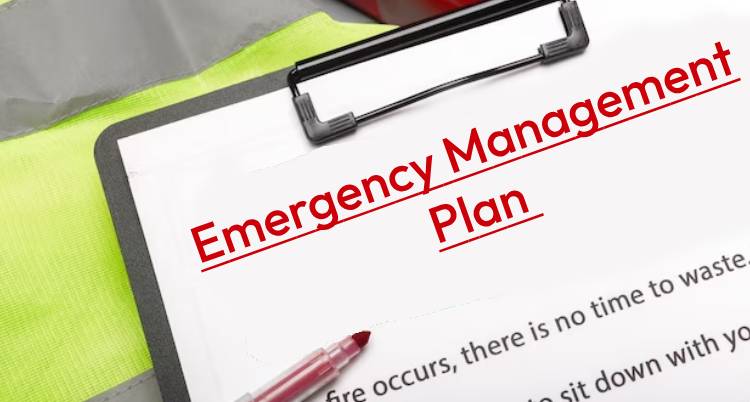What is an Emergency Management Plan?

An Emergency Management Plan is a concise and organized document outlining an organization’s strategies for preparing, responding to, and recovering from emergencies. It encompasses procedures, roles, and resources needed to safeguard lives, protect property, and ensure business continuity during adverse events, such as natural disasters or human-made crises. The plan includes risk assessments, communication protocols, evacuation procedures, and measures for ongoing improvement. The goal is to enhance preparedness and resilience in the face of unforeseen challenges.
Why Emergency Management Plan Required?

An Emergency Management Plan is a concise and organized document outlining an organization’s strategies for preparing, responding to, and recovering from emergencies. It encompasses procedures, roles, and resources needed to safeguard lives, protect property, and ensure business continuity during adverse events, such as natural disasters or human-made crises. The plan includes risk assessments, communication protocols, evacuation procedures, and measures for ongoing improvement. The goal is to enhance preparedness and resilience in the face of unforeseen challenges.
To be more specific, emergency response plans should include
- Who employees should contact, along with their contact information
- Evacuation routes
Steps to minimize risk for employees, operations and facilities
- Detailed communication plans for post-emergency preparedness
Steps to develop effective emergency response plan
Emergency response planning for business is a critical aspect of ensuring the safety of employees, protecting assets, and minimizing disruptions to operations in the event of unforeseen incidents. Here’s a guide to help you develop an effective emergency response plan:
1. Risk Assessment
- Identify potential risks and hazards that could affect your business
- Consider natural disasters, technological failures, security threats, and other relevant risks
- Assess the likelihood and potential impact of each identified risk
2. Emergency Response Team
- Establish an emergency response team with clearly defined roles and responsibilities
- Ensure team members are trained in emergency procedures
- Designate alternates for key roles in case primary members are unavailable
3. Communication Plan
- Develop a communication strategy for both internal and external stakeholders
- Establish communication channels (e.g., phone trees, messaging apps) and ensure redundancy
- Clearly define the chain of command for decision-making
4. Emergency Procedures
- Create detailed emergency procedures for different scenarios
- Include evacuation plans, shelter-in-place protocols, and medical emergency response
- Ensure procedures are easily accessible to all employees
5. Training and Drills
- Conduct regular training sessions for employees on emergency procedures
- Schedule and practice emergency drills to ensure everyone is familiar with the protocols
- Use drills to identify areas for improvement in the plan
6. Emergency Equipment and Supplies
- Maintain emergency kits with essential supplies such as first aid, flashlights, and blankets
- Ensure the availability and functionality of emergency equipment (fire extinguishers, AEDs, etc.)
- Regularly check and update supplies
7. Evacuation Routes and Assembly Points
Clearly mark evacuation routes and exits
- Designate assembly points where employees should gather after evacuating
- Consider individuals with mobility challenges and plan accordingly
8. Collaboration with Authorities
- Establish relationships with local emergency services and authorities
- Share your emergency response plan with relevant agencies
- Coordinate drills and exercises with local emergency responders
9. Business Continuity Plan
- Develop a business continuity plan to minimize disruptions during and after an emergency
- Identify critical business functions and prioritize their recovery
- Establish off-site data backups and alternative work locations
10. Review and Update
- Regularly review and update the emergency response plan to reflect changes in the business environment
- Incorporate lessons learned from drills and actual incidents
- Communicate updates to all employees
11. Crisis Communication
- Develop a crisis communication plan to address media, customers, and other stakeholders
- Designate spokespersons and ensure they are trained to handle media inquiries
- Provide accurate and timely information during and after an emergency
12. Legal and Regulatory Compliance
- Ensure that your emergency response plan complies with relevant laws and regulations
- Stay informed about any changes in legislation related to emergency preparedness
13. Employee Assistance Programs
- Offer support services for employees affected by emergencies
- Include information on counseling services in your plan.
Conclusion
In conclusion, an Emergency Response Plan is a critical component of organizational resilience. It serves as a strategic guide for effectively addressing unforeseen events, ensuring the safety of individuals, protecting assets, and maintaining essential operations during emergencies. By providing a structured framework for preparedness, response, and recovery, the plan enhances an organization’s ability to navigate and mitigate the impact of crises. Regular reviews, training, and updates contribute to the plan’s effectiveness, ultimately fostering a culture of safety and resilience within the organization.
Contact Us
Kindly call our Experts @ +91 8121563728 / +91 8015527650 or mail us @ kalyan.r@greenworldsafety.com / indumanasa.m@greenwgroup.com
Get Your Query Answered / Get Expert Assistance To Choose the Right Course for You Or Your Associates






